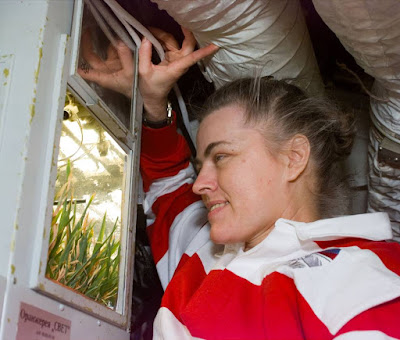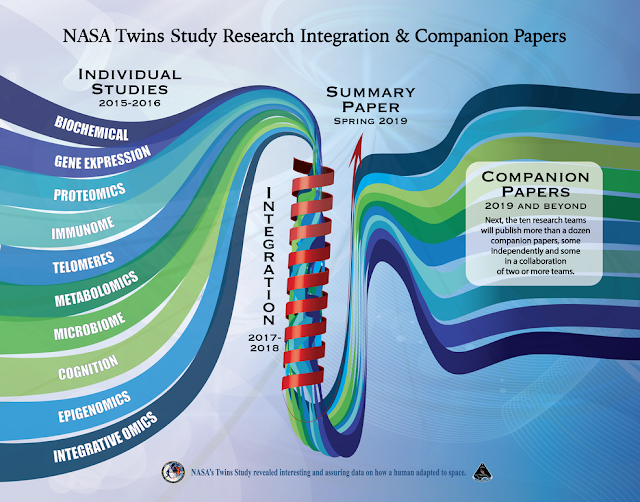
ISS - 20th Anniversary 1998-2018 patch / NASA - International Space Station (ISS) 20th patch.
March 2, 2020
Space stations provide the capability to support long-duration human space flights and the research needed to study the effects of extended periods of weightlessness on humans. The results of the investigations will inform future human exploration missions. Prior to space stations, the longest flight lasted only 18 days, although at the time (1970) it set an endurance record. The small size of the spacecraft not only precluded a longer stay due to lack of storage for consumables but also limited any significant medical monitoring or countermeasures equipment.
Space stations that preceded ISS (Top to bellow) Salyut, Skylab 1,
Salyut 6, Salyut 7 and Mir. The images do not show the stations to the
same scale.
Beginning with the first experimental space station Salyut in 1971, a series of Soviet and American platforms through the 1970s and 1980s played host to numerous long-duration missions, many setting ever-increasing endurance records up to 237 days. Beginning in 1986, the Soviet then Russian space station Mir hosted numerous long-duration missions during its 15 years of operation, extending the human spaceflight endurance record to 438 days, completed by cosmonaut Valeri V. Polyakov in March 1995. His 14-month spaceflight, long enough for a round-trip journey to Mars, remains the longest single space mission to date. Between October 1994 and March 1995, Mir hosted the first long-duration flight by a woman, cosmonaut Yelena V. Kondakova. As she and Polyakov prepared to return to Earth, astronaut Norman E. Thagard joined them in March 1995 as the first American to live aboard Mir, the first long-duration mission of the International Space Station (ISS) Phase 1 Program, also known as the Shuttle-Mir Program. In March 1996, Shannon W. Lucid arrived aboard Mir to begin the first long-duration flight by an American woman.
Top: Polyakov (right) assisting Kondakova with an experiment aboard Mir
in 1994. Bellow: Polyakov minutes after this return to Earth after 438
days in space in 1995.
Top: Thagard, the first American aboard Mir. Bellow: Lucid, the first American
woman to complete a long-duration flight aboard Mir.
woman to complete a long-duration flight aboard Mir.
The ISS provides a platform where scientists can conduct multi-disciplinary international studies on the effects of long-duration spaceflight on human physiology and psychology using instruments and techniques that can be regularly updated to keep up with advancing technology. With ISS nearing 20 years of continuous occupancy by rotating teams of crewmembers, the various investigations have adequate numbers of subject experiences available to reach significant conclusions. The first long-duration crew of William M. Shepherd, Yuri P. Gidzenko and Sergei K. Krikalev arrived at ISS on Nov. 2, 2000. Their replacements, the Expedition 2 crew of Yuri V. Usachev, James S. Voss and Susan J. Helms, arrived on March 10, 2001, and included the first woman to complete a long-duration mission aboard ISS. During their mission, the Space Shuttle delivered the first research racks including the Human Research Facility Rack 1 dedicated to conducting studies on human adaptation to long-duration spaceflight. Additional facilities to support an expanded range of investigations arrived on subsequent Space Shuttle flights.
Top: Expedition 1, the first long-duration crew to live and work aboard ISS
(left to right) Krikalev, Shepard and Gidzenko. Bellow: ISS Expedition 2 crew, the first to include a woman (left to right) Helms, Usachev and Voss.
(left to right) Krikalev, Shepard and Gidzenko. Bellow: ISS Expedition 2 crew, the first to include a woman (left to right) Helms, Usachev and Voss.
As of March 2020, ISS has hosted 170 long-duration crewmember flights of durations ranging from 48 to 340 days, with the majority in the five- to seven-month range. Of these, 152 were flown by males and 18 by females. In exchange for their contributions to the ISS Program, the European Space Agency (ESA) has conducted 13 long-duration missions, the Japan Aerospace Exploration Agency (JAXA) eight, and the Canadian Space Agency (CSA) three. The longest mission by an ESA astronaut was Luca S. Parmitano’s 201-day flight completed in 2020. Koichi Wakata holds the record for JAXA with his 188-day mission concluded in 2012, while Robert B. Thirsk’s 188-day flight in 2009 was the longest by a CSA astronaut.
Summary chart of long-duration experiences (longer than 90 days) completed aboard ISS.
Top: Parmitano after his return from his second long-duration mission to ISS.
Middle: Wakata being helped out of his spacecraft after returning from his second long-duration flight aboard ISS. Bellow: Thirsk relaxes after his ISS mission.
Middle: Wakata being helped out of his spacecraft after returning from his second long-duration flight aboard ISS. Bellow: Thirsk relaxes after his ISS mission.
In November 2012, NASA and the Russian space agency Roscosmos agreed to jointly conduct a one-year mission aboard ISS to better understand the effects on humans of such a lengthy exposure to space flight. The two agencies selected veteran space travelers Scott J. Kelly and Mikhail B. Korniyenko as the two participants in the mission. The pair launched to ISS with fellow crewmember Gennadi I. Padalka on March 27, 2015, and landed 340 days later with cosmonaut Sergey A. Volkov on March 2, 2016. The two participated in 23 investigations across seven research disciplines before, during and after their stay aboard ISS as members of Expeditions 43, 44, 45 and 46. Scientists presented the preliminary findings of their studies in January 2017. More information about the experiments and their results is available here. Additional one-year missions aboard ISS are in the planning stages.
Top: One-Year crewmembers Kelly (left) and Korniyenko before the mission.
Middle: Kelly and Korniyenko aboard ISS. Bellow: Korniyenko (left) and Kelly (right) with fellow crewmember Volkov (middle) after their landing in Kazakhstan.
Middle: Kelly and Korniyenko aboard ISS. Bellow: Korniyenko (left) and Kelly (right) with fellow crewmember Volkov (middle) after their landing in Kazakhstan.
Of particular interest to scientists, Kelly’s selection as the American astronaut to participate in the one-year mission proved fortuitous: he has an identical twin brother, Mark E. Kelly, also an experienced astronaut. This provided a unique opportunity for scientists to study the effects of a one-year mission on one astronaut, using his twin with a virtually identical genetic profile as a ground-based control subject. Both astronauts agreed to participate in the NASA Twins Study, a panel of investigations looking into the health effects of the long-duration mission, with Scott conducting the experiments aboard ISS and Mark on the ground. After the mission, the investigators jointly published the results of the Twins Study in the prestigious journal Science. A short video describes three of the major findings.
Top: Twin astronauts Mark (left) and Scott Kelly. Bellow: Schematic of
the NASA Twins Study research themes and publication plan.
Astronaut Christina H. Koch holds the title for the longest single
spaceflight by a woman after completing her 329-day mission in February
2020. Launched in March 2019, Koch participated in studies focused on
standard measures, a consistent set of core measurements taken from all
ISS crewmembers to characterize the effects of living in space for long
durations. Investigations recorded measurements in the categories of
behavioral health and performance, immunology, microbiology,
biochemistry, sensorimotor adaptation and cardiovascular adaptation.
Top: Koch minutes after her return from her record-breaking mission.
Middle: Padalka shortly after his return from his fifth long-duration mission.
Bellow: Whitson after returning from her third long-duration flight to ISS.
Middle: Padalka shortly after his return from his fifth long-duration mission.
Bellow: Whitson after returning from her third long-duration flight to ISS.
Russian cosmonaut Gennadi I. Padalka currently holds the title as the world’s most space traveled individual. Over the course of five long-duration mission, one aboard Mir and four aboard ISS, Padalka has accumulated 878 days in space, or nearly 2.5 years. In addition, Padalka also holds the record for the most birthdays celebrated in space, one during each of his four stays aboard ISS. Peggy A. Whitson holds the record for most cumulative spaceflight time for a woman as well as for any American astronaut. Over the course of three long-duration missions aboard ISS, she spent a total of 639 days or about 1.75 years in space.
Information gathered during these and future long-duration missions aboard ISS will provide the information needed for future programs to send the first woman and the next man to land on the Moon, for astronauts to live and work aboard the Gateway and one day undertake the first expedition to Mars.
The International Space Station as it appeared in 2018.
Related articles:
NASA Counts Down to Twenty Years of Continuous Human Presence on International Space Station
https://orbiterchspacenews.blogspot.com/2019/11/nasa-counts-down-to-twenty-years-of.html
20 memorable moments from the International Space Station
https://orbiterchspacenews.blogspot.com/2018/11/20-memorable-moments-from-international.html
Related links:
ISS research and technology: https://www.nasa.gov/iss-science
Humans in Space: https://www.nasa.gov/topics/humans-in-space
International Space Station (ISS): https://www.nasa.gov/mission_pages/station/main/index.html
Images, Text, Credits: NASA/Kelli Mars/JSC/John Uri/ROSCOSMOS/ESA/CSA-ASC/JAXA.
Best regards, Orbiter.ch
























